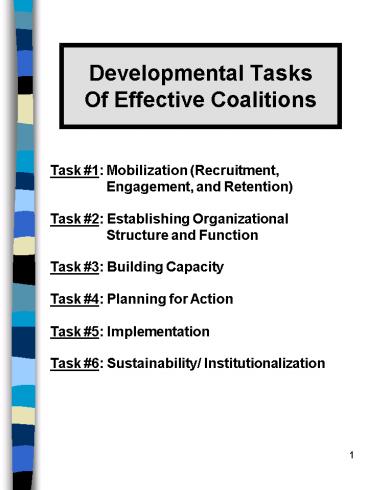Developmental Tasks Of Effective Coalitions - PowerPoint PPT Presentation
1 / 12
Title:
Developmental Tasks Of Effective Coalitions
Description:
... to recruit from and write the names and contact information of individuals next to the 'R. ... Nourish teams and networks. Generate a sense of community ... – PowerPoint PPT presentation
Number of Views:80
Avg rating:3.0/5.0
Title: Developmental Tasks Of Effective Coalitions
1
Developmental TasksOf Effective Coalitions
Task 1 Mobilization (Recruitment,
Engagement, and Retention) Task 2 Establishing
Organizational Structure and Function Task
3 Building Capacity Task 4 Planning for
Action Task 5 Implementation Task 6
Sustainability/ Institutionalization
2
Mobilization/Recruitment
- Recruit a critical mass of participants
- Why
- Broad Representation
- Different Opinions
- More talent
- More community support
- New community relationships
- How
- Develop a recruitment plan (who, what, where,
when, why, how?) - Identify potential throughout the community
- Methods of contacting potential members
(face-to-face, phone, via letter) - Involve people most affected by the problem
3
Mobilization/Recruitment
- Recruit a critical mass of participants
- Who
- Agencies and groups already active in ATOD
problem prevention - Community leaders from government and the private
sector who are opinion leaders and who control
resources - Major voluntary associations, religious
institutions, social organizations, etc. around
which community life revolves - Local community development groups (community
action agencies, etc.) - Representatives from cultural groups in your
community - Community members, such as adults, parents, youth
and the elderly
4
Activity 1 Coalition Recruitment Using the
coalition wheel, identify with an X which
sectors you currently have as members on your
coalition. Are all sectors represented? Which
other areas would you like to seek representation
from? Place an R in the sectors that you want
to recruit from. Identify the individuals/organiz
ations from that sector you want to recruit from
and write the names and contact information of
individuals next to the R. Work with a
neighbor to develop additional strategies to
create a plan for seeking out new membership to
enhance your coalition membership.
5
Mobilization/Engagement
- Engage representation from a broad spectrum of
key community sectors to find creative new
approaches, build ownership, and ensure
involvement when it is time for implementation. - Seven Practices of An Engaged Work Force
Social Capital Drivers - Establish an Open Learning Environment
- Nourish teams and networks
- Generate a sense of community
- Arrange work to minimize stress/maximize balance
- Grow exceptional leaders
- Embrace personal strengths
- Develop the capacity for dialogue
- Source T. Norris, Workforce Engagement, 2003.
6
Mobilization/Engagement
- How to keep people involved
- Know your audience
- Recognize needs/strengths of members
- Support other interests of groups
- Recognize that groups are made up of individuals
- Match talent with coalitions needs - FIT
- Welcome participants
- Show appreciation
- Know yourself
- Remain organized - use meeting time wisely
7
Activity 2 Engaging Coalition Members Review
the six Rs of participation listed and using
the worksheet, write down the answers to the
following questions What are we doing
now? What could we be doing? When you are
finished, compare your answers with other
members. What did you learn?
8
Mobilization/Retention
Benefits for Members
- Use existing skills. Learn new information and
skills- FIT - Gain personal recognition
- Improve the neighborhood or community
- Chance to help others
- Support the coalitions important mission and
goals - Attend meetings that are welcoming, provide
social opportunities, and are focused on the work
of the group - Networking opportunities inside and outside of
meetings. Relationship building. - Providing incentives and benefits for members
seemed to hold greater weight than the need to
reduce costs.
9
Mobilization/Retention
Costs for Members
- Time, effort and other things people give up in
other parts of their lives to participate - Perceived lack of appreciation
- Burn Out
- Lack of necessary skills to function in the
coalition - Feeling pressured for additional commitment
- Unresolved interpersonal conflict
- Lack of organizational progress
- Lack of direction from leadership
- Giving up activities with family and friends
10
- Activity 3 Cost/Benefit Analysis
- Think of a group of which you are a member.
Overall, how would you compare the benefits with
the challenges of being a member of this group? - Many more challenges than benefits.
- A few more challenges than benefits.
- About equal.
- A few more benefits than challenges.
- Many more benefits than challenges.
- What keeps you coming back? Why did you leave?
- Source T. Wolff, Neighborhood Leadership Action
Workbook, 1990.
11
Qualities of a Learning Coalition
- Create and reward a culture of inquiry
- Suspend judgment and take risks
- Learn through practice, make time for dialogue,
constructive conflict, and reflection - Articulate a collective vision and develop
actions that focus on outcomes - Develop and broaden the capacity for
collaborative leadership and problem-solving - Value diversity, engage the whole membership and
embrace new capabilities - Nurture both bonding (trust, cohesion) and
bridging social capital (interaction with other
groups) - Create and use feedback systems
- Celebrate achievements and successes
- Source T. Norris and C. Paterson, Linking
Community Indicators to Action and Policy
Exploring Practical and Applied Lessons, June
2003.
12
Levels of Sustainability
- Six Levels
- 1. Internal (Institutional) Strength identify
and address maintenance issues - Process for replacing members/cultivating new
leaders. - Sound organizational structure to facilitate
action/team spirit - 2. Strategic Planning and Implementation
- Turning the vision into reality
- 3. Communications- cultivate buy-in and
visibility - 4. Integration institutionalize efforts by
integrating programs, policies and services into
other community initiatives - 5. Financial Security
- Develop resource plan with diverse funding stream
- Cultivate in-kind (material, human) resources
- 6. Turn to the community champions- collaborative
itself is woven into community fabric































